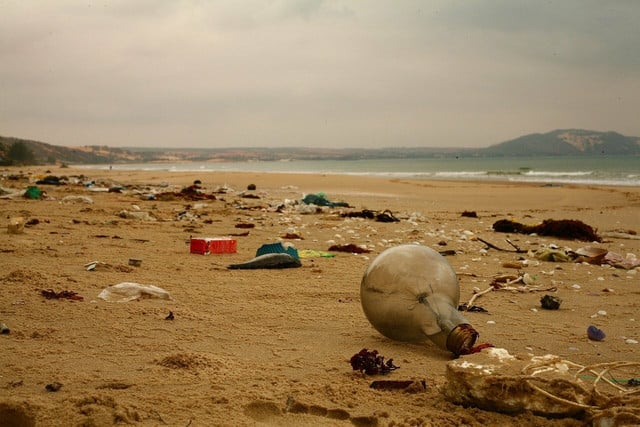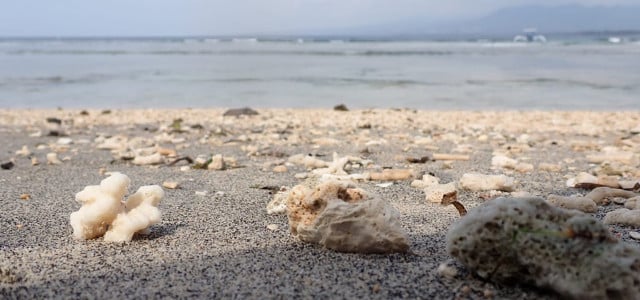Scientists and public health researchers are scrambling to understand just how harmful microplastics are — not only for humans — but for the planet at large. Their findings are concerning.
Water bottles, Tupperware, kettles, face wash — your innocuous plastic household items could be, and likely are, harming you in ways we do not yet fully understand.
Defined simply as fragments of plastic measuring less than five mm in length, microplastics are tiny fragments of plastic usually derived from broken-down plastic packaging for household items. They were also added as ingredients in skincare products in the U.S. until they were finally banned in 2015. Researchers have been aware of microplastic pollution for the last 20 years at least. However, these studies have predominantly focussed on the impact of microplastics on marine life, as they were first discovered on British beaches in 2004.
Since then, microplastics have been found pretty much everywhere. From the depths of the oceans to the summit of Mount Everest, in Arctic snow as well as tropical rain, in the bodies of tiny shellfish and floating invisibly in the air — and, most recently, the human body. Their prevalence has been well recorded. However, what we’re only just starting to wrap our heads around is the impact these particles are having on the planet and its inhabitants.
Microplastics Might Only Be the Half of It



(Foto: CC0 / Pixabay / sergeitokmakov)
Until recently, studies have focussed on the difficult task of discerning just how harmful microplastics — which come in an infinite number of shapes and sizes — are to animals, and in particular sealife. These studies, while limited in their conclusions, generally found that notable physical damage, predominantly regarding reproduction, was taking place.
Understanding the effects of these tiny pieces of plastic on living organisms is one thing. But what about microscopic ones?
Nanoplastics — which measure 1 mm or under — are more concerning. Most of these particles are invisible to the naked eye and even barely perceptible to scientists studying microplastic pervasiveness, meaning their effects are often not included in relevant data. Likewise, it’s recently been discovered that irregularly shaped microplastics are more likely to cause the death of human and animal cells than spherical ones, the shape that is most often used in studies.
Together, this means we actually have very little idea of how ubiquitous microplastic is in our environment, food or water, and, more importantly, how damaging it really is. What we can assume, however, is that this lack of real-life data means the problem is almost certainly worse than it appears on paper.
What We Don’t Know Won’t Hurt Us? Think Again
We have known for some time now that humans have been involuntarily consuming microplastics. However, in 2022, a study published by Environment International found that microplastics were present in the blood of 80 percent of participants.
Not only was the scale of the issue concerning, but the discovery shows what was long suspected, that microplastic particles can enter the bloodstream through other organs, such as the lungs and digestive tract. The impact of this is still unclear. However, recent studies show that:
- Microplastic moves from the lungs into the hearts, brains and other organs of the fetuses of pregnant rats
- … and humans.
- According to one study, microplastics are thought to cause tissue damage, oxidative stress, and changes in immune-related gene expression in fish.
- Microplastics could provoke immune responses such as allergies.
- They are thought to induce reproductive and developmental issues.
What scientists are scared of is the possibility that microplastics, or the toxins they produce, will, like other foreign particles, induce an immune response in the body that leads to scarring, fibrosis or cancer. However, it is impossible to study this conclusively without intentionally feeding a sample of the population microplastics to study their response. So, we need to wait for the long-term data to come through.
In the Meantime, Is There Anything We Can Do?
Right now, there isn’t really a way to protect ourselves from microplastic. Once the plastic has broken down and is in the environment, there isn’t currently a straightfoward way to remove it.
Understanding the scale of the problem is a good place to start. And, luckily, there are an enormous amount of studies being published on the topic every year, which means progress in widespread understanding of the issue is likely going to come quickly.
Until politicians listen to the science and put pressure on manufacturers to find clean, safe materials, we’re not going to be rid of the problem entirely. And, without sounding too nihilistic, there’s probably no way you’re going to be able to avoid microplastics entirely.
However.
There are a few things you can do to reduce your exposure to microplastics:
- Reduce your use of single-use plastics. This is particularly true for disposable eating and drinking utensils; these are especially bad plastic packaging as the polymers used for these products are among the most commonly found in the environment.
- Of course, use as little plastic as possible. Going (or at least trying to go) plastic-free will help you to stop adding to the problem.
- Redecorate less frequently, as paint is the single largest contributor to microplastics.
- Drive less, drive more gently, and buy longer-lasting tires. Tires are thought to contribute to 1.5 million metric tons of pollution in the US environment annually.
- Avoid heating up plastic to a high temperature, particularly anything you eat and drink from. This includes microwaving food in plastic.
- Avoid buying new clothes. Clothing is one of the biggest sources of microplastic pollution in the world.
- Wash clothes on as low a temperature as possible, or, better yet, install a filter.
- Research plastic-free cosmetics and buy them next time you run out. Lotions, makeup, toothpaste and everything in between likely contains plastic that breaks down and can be absorbed by your skin. Reduce buying plastic products wherever possible.
- Limit seafood consumption. Microplastics have been found in 386 aquatic species, of which over 50 percent are available on supermarket shelves. Also, detritus from fishing, including nets and ropes makes up around 10 percent of all ocean trash.
- On that note, we recommend sticking to a natural diet with as few animal products as possible. Shop at local farmer’s markets to avoid harmful plastic directly touching your food.
Read more:
- Life Without Plastic: Easy Tips for Everyone
- Black Plastics: Why Are They So Bad for the Environment?
- Plastitar: A New Type of Pollution, Thanks to Oil Spills and Microplastics
Do you like this post?







